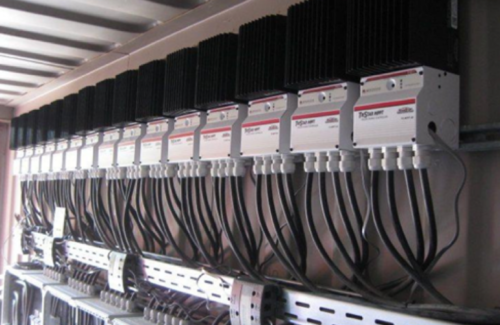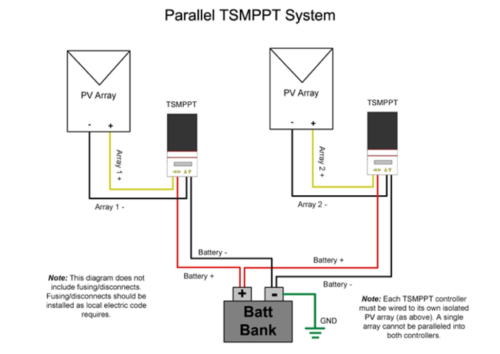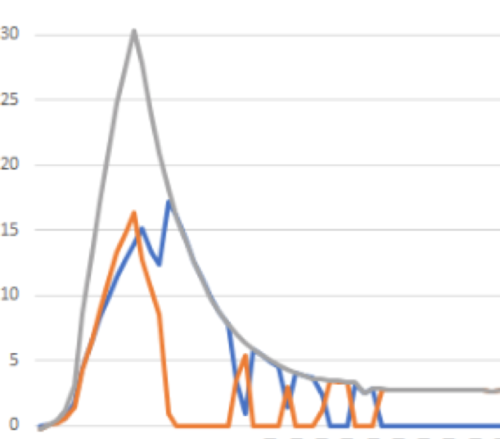 This installation tip was provided by Douglas Grubbs, applications engineer at Morningstar Corporation
This installation tip was provided by Douglas Grubbs, applications engineer at Morningstar Corporation
Large off-grid solar and battery backup PV systems often require greater charging than a single controller can provide. To meet high power charging requirements, several solar controllers can be connected in parallel to a battery bank with each controller connected to its own separate PV subarray.
For MPPT controllers, MPPT tracking of each subarray is preferred, as there is less impact with voltage mismatches. In addition, failure with one controller will not affect the solar production from the rest of the array. Another consideration is that BOS requirements for larger arrays can be more challenging. Therefore, multiple solar controllers with separate subarrays should be considered not only feasible, but optimal.
When using parallel solar controllers, the battery must be sized to handle the combined charging current as recommended by the battery manufacturer. It’s also important to note that each controller will have its own separate solar array, with each array configured in accordance with the solar controller specifications.
Morningstar’s TriStar and TriStar MPPT controllers’ voltage regulation is accurate enough to synchronize and coordinate the charging regulation for parallel operation without the need for intercommunication. The controllers will transition to and from the different charging states at approximately the same time if all of the following conditions exist:
- All of the controllers are set with the same charging profile.
- A common battery voltage sense is connected to each controller. A
- battery remote temperature sensor (RTS) is used with every controller.
During absorption (or boost) charging, the parallel controllers will start limiting the voltage at approximately the same time, since they will all be sensing the same voltage and have the same charging profile. The controllers may end absorption charging at slightly different times, but this will typically be of little or no consequence.
The monitoring of the system in Figure 2 shows that the charging can alternate between the controllers. However, the total combined charging will fully charge and maintain float.







If the system needs a Total PV Power of 4000W. Can a two (2000w) PV array with two parralleled MPPT sustain its needs?
What is the problem if we connect the same solar panel to two controllers in parallel which in turn each one is connected to a different battery. My point is that I’m using different batteries for different uses and I want both of them to be charged.
Jadou
did you end up doing this i want to do the same thing and cannot find any info on it
chris
An interesting question ! I personally don’t see any issue with this arrangement, and I do see advantages.
I think the two controllers can only share the total power the solar array is able to harness at each point in time.Two issues quickly come to mind.First,if the charge controllers are not the same make,one will tend to be more efficient at harvest the solar power at the detriment of the other.Second,if the total current produced by array is not enough to charge the two batteries at the same time,the two batteries will suffer from poor charging.
I tried this and it did not work well. Every so often, depending on load it seemed, they would almost fight over the voltage and it would have sudden drops and spikes. From what I know about PWM controllers and how they are supposed to be more constant instead of adaptive, PWM may actually handle it better. But for me I only tried it for 2 days to see if things would level out and they didn’t.
Things will never level down because everything boils down on the total energy the entire PV array can harness.A situation where your two 200ah batteries need a minimum of forty amps to charge and the total your PV array can afford even if you bring China’s artificial sun to the surface is thirty amps,which is not good enough for two 200ah batteries.
I don’t think it will do well as the power from the panel can either flow to one direction more than the other and vice versa.
Consider separating the models to work independently .
Use a DC to DC charger to charge the other set of batteries
Could I use a 40 amp mppt with a 370 watt 48 volt solar panel. and use the mppt as my battery monitor with 10 mppt’s and 10 solar panels. one for each battery for a 1000 amp hour battery bank
Hi Morningstar, I have existing tristar MPPT-60 controller and planning to buy again tristar PWM
my question is two controllers can be parallel both Tristar MPPT and Tristar PWM shared in common battery bank?
kindly enlighten me.
Thanks.
Is parallel inter communication wiring possible with TriStar ts- 45?
At this time we do not offer parallel inter communication between controllers.
You may find our parallel white paper of interest.
https://www.morningstarcorp.com/parallel-charging-using-multiple-controllers-separate-pv-arrays/
Should the parallel controllers be the same size and brand, or can you use different sizes with different brands? I assume you shouldn’t mix MPPT with PWM’s, right? Thanks.
I have the same question..
The folks at Morningstar could probably answer that question most effectively!
You have got the same answer
Parallel controllers do not need to be the same size. The main thing is that they have the same settings and voltage sense and Remote Temperature sensors are used with both controllers.
Using other brands in parallel has been done effectively though I can’t vouch for the voltage accuracy with other brands. Higher accuracy helps with synchonizing the charging.
For more info about parallel charging see out white paper.
https://www.morningstarcorp.com/parallel-charging-using-multiple-controllers-separate-pv-arrays/